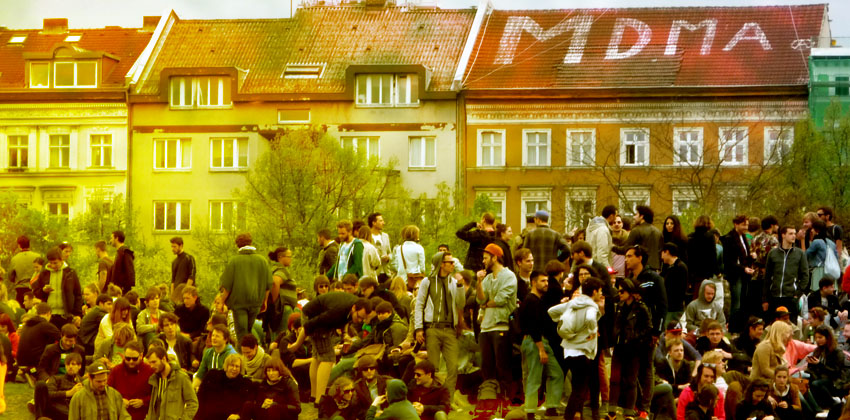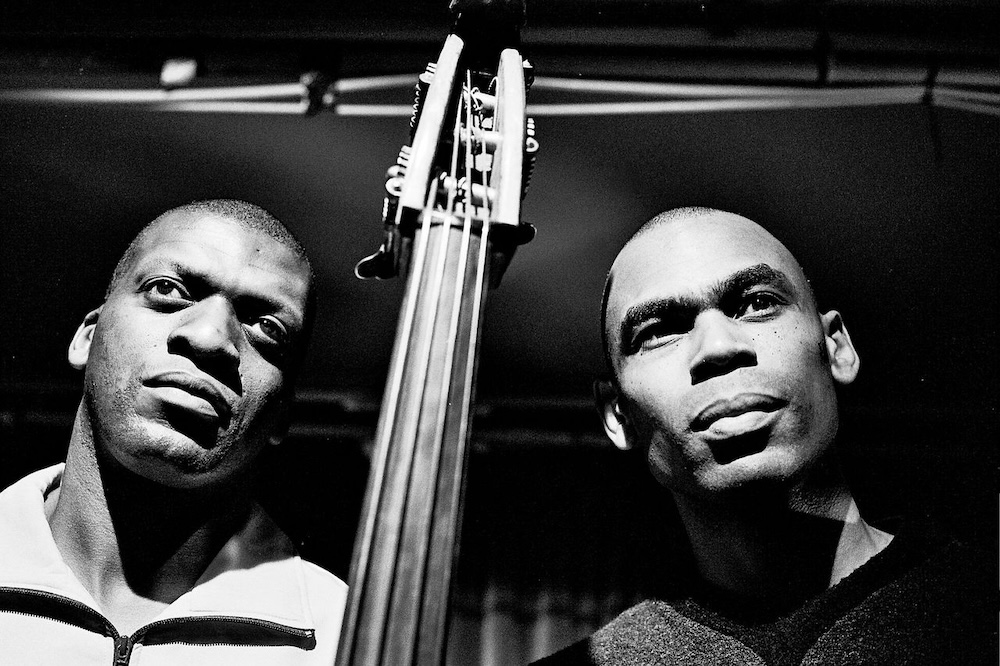Gone To A Rave #13: Acid Techno

Gone to a Rave has so far concerned itself with the unarguably credible; jungle, hardcore, early house, garage – they’ve all been comprehensively co-signed by the style press, eulogised products of a lively and innovative UK dance culture, ripe with fashion to be knocked off and beats to rinse. Even formerly pariah scenes such as happy hardcore have had their time sunning in the zeitgeist – I vaguely remember Goldsmiths Union –chief HQ of art school appropriation – booking Hixxy and Sharky during the height of new rave in an ill-fated hipster homage to the Bonkers comps the two used to churn out.
This week though, this week we’re delving into the murky territory of the perennially uncool. This week we’re going into a scene dear to my own heart, a scene that’s long due some props. This week we’re talking the hated, feared, ungodly world of ACID TECHNO.
Whilst Acid House is revered and revived weekly, acid techno is the ugly step bastard. No one mentions it, no one admits to loving it, and no one wants to be seen in its company. The scene sprung up – and still clings on – in the squats, social centres, crumbling warehouses and blacked out dives of London’s industrial edges, a vicious punk reimagining of the acid house aesthetic. It’s gone on to be remarkably successful worldwide, yet it maintains almost zero mainstream profile. As London property prices lurch from offensive to insane, developers are snapping up previously disregarded areas, repurposing derelict factories into ‘urban lifestyle experiences’, and it’s quite possible that, as a result, the scene may find itself gentrified out of existence. Similar to its Detroit uncle, Acid Techno has always seemed intertwined with the architecture of its environment; ancient hedonistic urges reshaped by the bludgeon of brutalist design. Now the warehouses and social centres of Hackney Wick and Brixton, traditional heartlands of London’s Acid Techno free party scene, have been chopped and scrubbed into anonymous living units, there’s only really (as far as I know) the North London industrial estates around Tottenham left. When the day comes and Edmonton gets turned into luxury condos for aspirational fuckers, acid techno, and the free party scene it springs from will most likely leave the capital for good.
I’ve tried pitching articles on the outlaws who created the early acid techno classics to a couple of publications only to be met with deafening silence – it truly is persona non grata. I’d say there are a few reasons for this:
1) It was a scene run by people with an almost universal contempt for the mainstream – for mainstream press, fashion, music and lifestyle.
2) It was pretty much entirely lacking in any of the traditional concepts of glamour that are associated with clubland. Most acid techno events were in fact, guttersnipe inversions of any usual concept of glamour.
3) None of the producers ever bothered trying to make a pop hit out of the music.
4) There’s long been a hate for anything seen as ‘crusty’ – check this recent comment from Quietus writer Luke Turner – “What I don’t like about much of the older acid/hard techno is the stink of dreadlocks, rather crusty, very male” – I’ve got to point out here that neither I, nor any of my friends, who were raving to acid techno back in ’96 had dreadlocks. There were also a lot of women at the clubs/ raves – far, far more than at any of the ‘purist’ techno do’s I’ve since been to. The early days of FFWD at Plastic People – now that was a real sausage party, but I doubt Turner would so casually dismiss it as such – it is, after all, an accepted part of ‘credible’ dance. Essentially he’s judging an historical scene by it’s contemporary equivalent – which is kinda like imagining Metalheadz at the Blue Note was full of Rudimental fans. Hey ho.
This is a real shame, although not much of an issue for fans of acid techno – they just keep on keeping on. However, I’d argue that there was a mid 90s golden period that deserves attention– this was before the Ketamine (still legal at the time) flooded the scene and dragged the music down into dark, horrible K-Caverns. Pre-Ketamine influx there was a time when a rash of London based producers, stretching across the city, but coalescing round South and East London, started pushing a unique sound, a particular stripped back form of acid that prioritised hedonism, chucking out anything that didn’t directly serve to work the crowd. For a period roughly spanning ‘95-‘97, a handful of labels – Stay Up Forever, Routemaster, and Choci’s Chewns being the most obvious – produced a non-stop head rush of high speed mentalist 303 abuse, nailing a few classics and frying a few minds.
The indisputable leaders of the acid techno movement were the Liberators –three DJs, Chris, Aaron and Julian all coming from a squat punk background, with Chris Liberator having a particularly notable history as the drummer of anarcho-punk outfit Hagar The Womb – check out their track ‘Dressed to Kill’, for a brilliant punk knock off of Boney M’s ‘Gotta Go Home’ (which ended up recently soundtracking a million shitty parties as Duck Sauce’s ‘Barbara Streisand’). Since starting to write this piece I’ve managed to order an LP of Hagar the Womb’s albums (which shows you how long it takes me between starting to write em and finishing…!) and I also want to share this tune from them, some excellent goth-y post punk.
When Hagar fell apart in the mid 80s, Chris played drums in a few indie bands before drifting into the early rave scene. He’s told interviewers that he felt out of place in the ‘the white jeans, white gloves and glow-stick culture in commercial raves and clubs” so started putting on his own free parties after meeting Julian and Aaron, the trio playing a mix of Underground Resistance, European hard trance from the likes of Hardfloor, and the meaner, hoover heavy side of UK rave labels like Rising High were putting out. After a couple of years of this they were ready to put together their own Stay Up Forever label, experimenting in melding acid lines and trance – despite not having a 303. The early releases showed willingness, but lacked the raw power that later defined the label.
It was only upon meeting the studio maestro Henry ‘Dave the Drummer’ Cullen and fellow acid enthusiast Dave DDR that SUF really took shape. In 1995 they chucked out a couple of releases that redefined their sound, cutting out the floaty hippy bollocks of trance to leave a lean London noise, a music that didn’t try to elevate away from the urban decay, the rave-averse government , the sketchy pills, and the contrarian politics of paranoid squat living, but instead worked within them, crafting grotty realities into jubilant festivities.
‘Firefight’ and ‘The Rabbit’s Name Was’ laid the blueprint, becoming big tunes with techno DJs across the board, joining classics such as ‘Access’ and ‘Acperience’ in the pantheon of harder acid bangers. For the pure acid techno scene it was only the beginning of a short lived burst of 303 domination, tune after tune of acid squiggles layered into ever crashing crescendos.
In 1996 Routemaster Records burst onto the scene with the all-time classic ‘London Acid City’, produced by Chris Liberator and Laurie Immersion under the Lochi guise (funnily enough, a decade or so later Laurie Immersion ended up cutting and mastering the majority of the Supersound releases, bringing an understanding of booming soundsystem aesthetics to disco reissues). The track was carried by a 303 line perfect in it’s simplicity, and a vocal loop ‘London Acid City – our time is now’ that was both a call to party, and a threat to authority. The record became an anthem for a new generation of activists, a collection of dissatisfied wasters, slumming rich kids, genuine revolutionaries, new age travellers, shameless drug buckets and total nutters, who are – rightly or wrongly – usually lumped together under the umbrella of crusties. The Reclaim the Streets movement was born to an acid techno soundtrack, with that strain of civil disobedience culminating in the Mayday Riots of the early noughties. Stuck in the middle of the May Day 2000 riot, coming up fast off a couple of Mitzi’s, I can attest that acid techno was the music of choice banging out of the soundsystems, pounding kicks matched by swinging lump hammers as masked anarchists smashed the shit out of the Mercedes Benz showroom. Routemaster records had long flirted with thuggish political messages, albeit with a tongue firmly in cheek, as on ‘Vote Techno Party’ – the claps of which sound strangely like the rigid whipcrack percussion pattern used on Youngsta’s iconic grime track ‘Pulse X’
Unsurprisingly for an outsider scene, the records coming out on Stay Up Forever, Routemaster and Choci’s Chewns were tricky to get, unless you went specifically to the Choci’s Chewns shop in Carnaby Street, a basement store with 303 bangers on constant rotation. Choci himself had been a hardcore producer, creating the doom laden breakbeat anthem ‘Hoovers and Spraycans’, way ahead of its time on its 1991 release:
When he moved into supporting the acid techno scene, Choci’s was one of the only record shops whole heartedly getting behind the sound. As well as stocking the various scene labels, Choci was bringing out his own tracks- in hindsight they’re slightly outside the pure acid techno format, with (to my mind unforgivable) extensive uses of synths OTHER THAN A 303. There were long breakdowns, arps, the works – it’s more like the roughest edge of acid trance as these tracks show – at times the swirling arps of ‘Mesmerised Children Playing’ sound like cyborgs playing prog rock..
As I’ve previously mentioned, Ketamine tore through Acid Techno, decimating the music as it went. The early Stay Up Forever releases had an MDMA fuelled optimism to them – they were made by people who took pleasure in their outsider status, daring to believe that they were crafting a blueprint for future living. The bubbly acid of Dynamo City’s ‘Urban & Free’ pretty much sums up the ethos – it’s the inner city dreaming of a concrete utopia, the words ‘urban and free’ booming from makeshift rigs to raving kids, high on a heady mix of pills, sedition and hope. A few years on and the vibe had changed. Now Dynamo City were making ‘One Night in Hackney’, a UK parody of The Horrorist’s ‘One Night in New York’ – and this time there was no optimism or search for freedom; now the only thing that mattered is getting so off your face that reality fades to a dirty smudge. The acid was reduced to a thundering pound as the narrator tells a story that ends up with him downing 15 cans of Stella.
Kektex’s 1997 hit ‘Inner City Junkie’ (lyrics: “got my spoon cooking, brown banging, skunk smoking, rock toking, ket sniffing, coke chopping, base popping E! tequila slamming, butt rolling, inner city junkies”) is on a similar tip – there’s a knowing silliness to the tracks, the producers taking the piss out of their own scene’s drug dependency, but I can’t help feeling that they pin point the moment utopia got postponed- something far grubbier seemed far more obtainable.
For a comprehensive round up of the best of acid techno’s early years, you can’t really do better than listen to the Liberator’s 1997 compilation – “It’s Not Intelligent, It’s Not From Detroit, But It’s Fucking Aving It!!” There’s little I can add that can sum the scene up better than that genius title – comically contrarian, full of punkish pisstake, and ready to party. For a while the acid techno innovators of London had it all going on, ushering in a chaotic headrush of music that’s as pure an energy blast as your gonna find in UK rave history. It’s never been cool, and it probably never will be, but true to the title of hte compilation, it’s always going to be aving it…
Ian McQuaid is on one on twitter


















Must Reads
David Holmes – Humanity As An Act Of Resistance in three chapters
As a nation, the Irish have always had a profound relationship with the people of Palestine
Rotterdam – A City which Bounces Back
The Dutch city is in a state of constant revival
Going Remote.
Home swapping as a lifestyle choice
Trending track
Vels d’Èter
Glass Isle
Shop NowDreaming
Timothy Clerkin
Shop Now